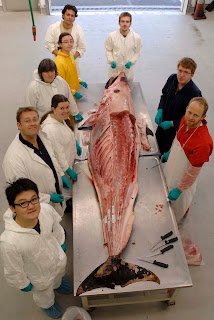The pygmy right whale (
Caperea marginata) is one of the most poorly known and least understood of all modern baleen whales. The conservation status of
Caperea is listed by the IUCN as data deficient.
Caperea is a "small-bodied" mysticete, and is typically 7 meters in length as an adult; the pygmy right whale shares several skull features with true right whales (Balaenidea:
Eubalaena spp. and
Balaena) such as an arched rostrum and a mandible without a coronoid process. Historically, the mysticete fossil record has been 'plagued' with a lack of fossil pygmy right whales, and the phylogenetic position of
Caperea has been contentious in molecular and morphological analyses. Skeletons of
Caperea are generally rare in museums in North America, although they're relatively common here in New Zealand (and we have one sitting in one of our Ph.D. student offices).
A pygmy right whale dissection by the Fordyce lab and various other parties (this was a while before I started here at OU). Starting clockwise from lower left: Yoshi Tanaka (OU); Anton Van Helden (Te Papa); Carol Loch Silva (OU); Moyna Muller (OU); Monica Buono (CENPAT); Gabriel Aguirre (OU); Felix Marx (OU); and two gentlemen I haven't met (if anyone can identify them I'll update this caption).
From http://www.otago.ac.nz/geology
The lack of pygmy right whales in the fossil record is in stark contrast to balaenopterids and balaenids, which are some of the most common mysticetes in Pliocene strata, and are known from the early and late Miocene (respectively). Even up until a few years ago, the Eschrichtiidae - Gray Whales - were known only from a late Pleistocene skull and skeleton of the modern species from Los Angeles County. A number of latest Miocene and Pliocene finds from Japan, Italy, and California have (finally) elucidated (some of) the evolutionary history of gray whales, leaving pygmy right whales the last real 'frontier' (so to speak) in mysticete paleontology (although to be honest, the gray whale fossil record is still wanting in most respects).
The entirety of the published fossil record of neobalaenid whales, a posterior process of a petrotympanic (earbone) there on the left side, with a modern Caperea petrosal for comparison. From Fitzgerald (2012).
A new study by my colleague Erich Fitzgerald in the most recent issue of the Journal of Vertebrate Paleontology reports a partial earbone of a pygmy right whale (Neobalaenidae indeterminate) from the latest Miocene of Beaumaris in southwestern Victoria, Australia. The new find is an isolated compound posterior process of a petrotympanic (in most mysticetes, the posterior process of the petrosal and tympanic bones are fused together into one element). It shares with modern
Caperea a very large, inflated, and conical posterior process, but given its incompleteness, it is not really possible to identify it past the family level (Neobalaenidae).
Phylogenetic position and stratigraphic range of neobalaenids. From Fitzgerald (2012).
Although the fossil is fragmentary and doesn't really answer any questions about character transformations in ancestors of the pygmy right whale (something which will require complete crania), it does establish for the first time that some of the weird basicranial features of
Caperea have been around since at least the Miocene. That being said, more complete fossil neobalaenids were announced last year at the 2011 annual meeting of the Society of Vertebrate Paleontology by John Graf et al. of the Southern Methodist University; these include two Miocene fossil mysticete skulls from the Atlantic coast of Angola in southwestern Africa. A 'sneak peek' of the Angolan fossils popped up during Lou Jacob's presentation a year ago at the Aquatic Tetrapods meeting in San Diego, which was the first time many of the mysticete researchers in the had heard of a fossil neobalaenid, and I remember looking around and seeing other folks with their mouths dropped open (mine was). I'm skeptical of the familial assignment of these Angolan fossils, but I'll reserve judgement until they are published.
References:
Fitzgerald, E.M.G. 2012. Possible neobalaenid from the Miocene of Australia implies a long evolutionary history for the pygmy right whale
Caperea marginata (Cetacea, Mysticeti). Journal of Vertebrate Paleontology 32:976-980.
Graf, J., Jacobs, L., Polcyn, M., Mateus, O., Schulp, A. 2011. New fossil whales from Angola. Society of Vertebrate Paleontology 2011 meeting abstracts: 119A.




























